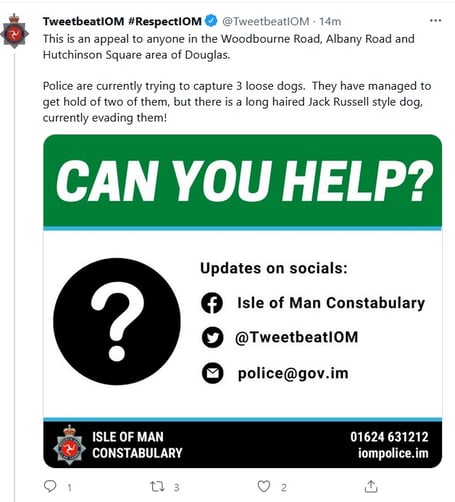The island’s police have been praised for their interaction with the community through their expanding use of social media.
A report by INEQE Safeguarding Group was conducted in 2021, which found that up to 82% of the island’s population are being reached through Facebook alone.
In its report, INEQE said that the island’s force ‘compares favourably’ with Guernsey’s, both serving similar communities, albeit with the Isle of Man having a larger population.
By contrasting the two, the report found that the Manx police ‘boasts a good engagement on Facebook with 69,000 followers, exceeding Guernsey’s 25,200 by 37%’.
It added: ‘In relation to citizen engagement, the Isle of Man Constabulary performs well on Facebook, potentially reaching over 82% of the population. Acknowledging that the number of followers may fluctuate during major events with an influx of visitors eg the TT, this number remains relatively stable, and most of their following is assessed to be local people.
‘This is an encouraging statistic for the Isle of Man Constabulary as it demonstrates that the use of social media appears to be an effective tactic in terms of reaching out to the community.’
By comparison, as of April 2022, The Met had 343,000 followers on Facebook, which accounts for just roughly 3.6% of London’s 9,541,000 citizens.
However, the report warned that the police cannot rest on their laurels with Facebook, as younger people, particularly the 13- to 17-year-olds make up the smallest number of Facebook users in the UK and Facebook is the most popular social media network for those aged 35 and over.
Twitter is less successful for the police, reaching just around 20% of the island’s population. However, that may also reflect that far fewer islanders use Twitter compared with Facebook.
Key to engaging with younger members of the society is through the use of other social media platforms such as Instagram and Tik Tok.
The report found that while the police only reach about 15% of the population using Instagram, this actually reflects a positive position.
INEQE said: ‘Despite much smaller numbers when compared to their Facebook following, the Isle of man is performing well on this platform and exceeding the community engagement of other forces.
‘Investing in resources that increase its Instagram use will help the constabulary target a key demographic, as most Instagram users in 2022 were 25- to 34-year-olds.’
As for Tik Tok, something which the island’s police have begun to use more frequently in recent months, the report the platform ‘offers a unique opportunity to capture the younger demographic’.
INEQE added: ‘The Isle of Man TikTok page is as yet unverified but has captured 16,300 followers and a total of 208,300 likes. Their most liked video has 1.2 million views and 93,800 likes. This exceeds their estimated population and shows the extent to which TikTok may target a demographic not otherwise reached via Facebook, Twitter, or even Instagram.’
Elsewhere while the police do not use Snapchat, the report said it is something that should be considered given the platform’s usage by teenagers unlikely to engage with other social media.
The report also recommended that the police consolidate their many pages into one central information account, with the community pages, such as the north/south/west neighbourhood policing pages, being used to keep in touch with residents in their areas.
While the report was largely complimentary of the police’s use of social media, there are many areas which INEQE found the police need to improve on.
Some of these recommendations, such as quickly removing personal information, such as pictures of missing people and children, can already be seen to be in place by the police.
Other areas tended to focus around how social media is used. This includes training staff on what tone the police should take and the completion of mandatory training before access is granted to officers or staff responsible for posting on social media.
The training, it was recommended, should focus on copyright usage, strategic objectives, risk management, data protection and other areas.
Looking externally, INEQE also recommended that the police conduct research with people of different backgrounds and demographics to determine what platform they are best using, continuing to work with the traditional media and ensuring that their posts reflect the realities of policing.
The report referred to the last point in particular with some officers saying they recognise the value in showing officers engaging with the public, but that this needs to be balanced to avoid skewing the public’s impression of what officers are doing.
As one officer said: ‘We seem to use it enough for humour and general engagement but we don’t put enough information out about the serious issues we have to deal with and therefore I think the public have a very skewed idea about what we have to deal with regularly and they think it is all pink and fluffy being an officer on the Isle of Man.’




.jpeg?width=209&height=140&crop=209:145,smart&quality=75)
Comments
This article has no comments yet. Be the first to leave a comment.